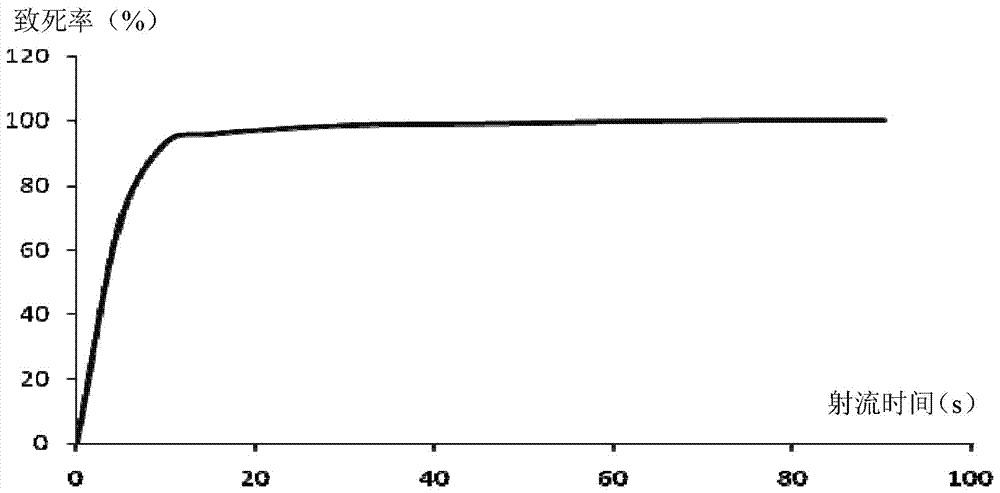Streptomyces hygroscopicus mutant strain for highly yielding ascomycin, and application thereof
A technology of Streptomyces hygroscopicus and ascomycin-producing technology, which is applied in the field of microorganisms, can solve the problems of high negative mutation rate and resistance saturation, strain viability, weakened spore production, etc., and achieves stable titer, good stability, and improved Yield effect
- Summary
- Abstract
- Description
- Claims
- Application Information
AI Technical Summary
Problems solved by technology
Method used
Image
Examples
Embodiment 1
[0015] Embodiment 1, the isolation of bacterial strain FIM-311
[0016] (1) Collect the soil under the forest of Guling, Fuzhou City, Fujian Province. Specifically, use a sampling shovel to remove the surface soil of about 10 cm, and collect 10 g to 25 g of soil samples at 10 cm; weigh 2 g of soil samples and add 10 mL of sterile saline After oscillating, let it stand for 30 minutes, take the supernatant, that is, the original solution, and carry out gradient dilution with sterile saline, and the selected dilution is 10 -2 、10 -3 、10 -4 and 10 -5 suspension;
[0017] (2) Take 0.1 mL of the stock solution and the selected suspension and spread them on the oat agar medium plate prepared by adding 50 mg / L potassium dichromate water, repeat 3 parallel plates for each sample, and then spread the coated Place the plate at 28°C for culture, and observe the morphological characteristics such as colony appearance, size, color, edge shape, and surface dry and wet state;
[0018] (3...
Embodiment 2
[0019] Embodiment 2, identification of bacterial strain FIM-311
[0020] (1) Physiological and biochemical characteristics identification: The obtained strain FIM-311 was streaked on oat agar medium plate and inserted into a cover glass, cultured at 28°C for 7-20 days, and observed by optical microscope, transmission and scanning electron microscope. Morphological characteristics of the colony and its hyphae. The main morphology and physiological and biochemical characteristics of the bacterial strain FIM-311 were obtained as follows:
[0021] There are 10-42 spores in the mature spore chain, and the shape of the spores is oval or cylindrical, 0.5-0.7×0.7-0.8 μm. The spores gather in piles and produce black spots; on the plate, the colony is round, and the diameter of the colony is about 5-6mm after 10 days of culture. The center protrudes, and the surface is wrinkled, light gray or gray black. Pigment, aerial hyphae absorb water, and as the culture time prolongs, the colony...
Embodiment 3
[0025] Embodiment 3, the acquisition of bacterial strain FIM-311-80
[0026] (1), take the bacterial strain FIM-311 and transfer it to the slant medium, and cultivate it in a constant temperature incubator for 8-12 days, and the culture temperature is 28°C; wash the bacteria on the slant medium with physiological saline afterwards The spores were broken up with glass beads and filtered through gauze to make 10 6 Individual / mL spore suspension;
[0027] (2) Use a pipette gun to draw 10 μL of the spore suspension prepared in step (1) on a circular iron sheet with a diameter of 1 cm, place it with helium as the working gas, the power supply is 110W, and the working gas flow rate is 10L / min In the atmospheric pressure room temperature plasma mutagenesis system, and the treatment distance is 2mm, respectively, 5s, 10s, 15s, 30s, 45s, 60s, 60s, 75s, 90s were treated, and the treated spore suspension was gradiently diluted and spread on a plate. Make a lethality curve (such as fig...
PUM
 Login to View More
Login to View More Abstract
Description
Claims
Application Information
 Login to View More
Login to View More - R&D Engineer
- R&D Manager
- IP Professional
- Industry Leading Data Capabilities
- Powerful AI technology
- Patent DNA Extraction
Browse by: Latest US Patents, China's latest patents, Technical Efficacy Thesaurus, Application Domain, Technology Topic, Popular Technical Reports.
© 2024 PatSnap. All rights reserved.Legal|Privacy policy|Modern Slavery Act Transparency Statement|Sitemap|About US| Contact US: help@patsnap.com








